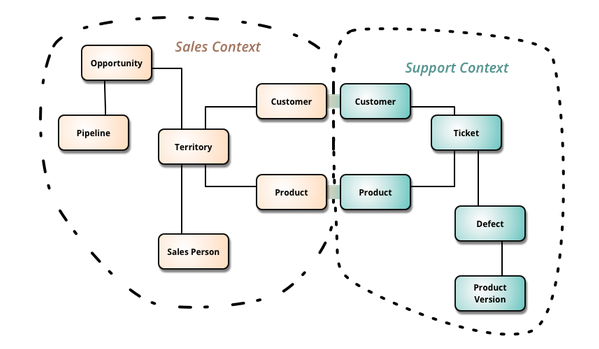Bounded Context
From http://martinfowler.com/bliki/BoundedContext.html
Bounded Context is a central pattern in Domain-Driven Design. It is the focus of DDD's strategic design section which is all about dealing with large models and teams. DDD deals with large models by dividing them into different Bounded Contexts and being explicit about their interrelationships.

DDD is about designing software based on models of the underlying domain. A model acts as a UbiquitousLanguage to help communication between software developers and domain experts. It also acts as the conceptual foundation for the design of the software itself - how it's broken down into objects or functions. To be effective, a model needs to unified - that is to be internally consistent so that there are no contradictions within it.
As you try to model a larger domain, it gets progressively harder to build a single unified model. Different groups of people will use subtly different vocabularies in different parts of a large organization. The precision of modeling rapidly runs into this, often to leading to a lot of confusion. Typically this confusion focuses on the central concepts of the domain. Early in my career I worked with a electricity utility - here the word "meter" meant subtly different things to different parts of the organization: was it the connection between the grid and a location, the grid and a customer, the physical meter itself (which could be replaced if faulty). These subtle polysemes could be smoothed over in conversation but not in the precise world of computers. Time and time again I see this confusion recur with polysemes like "Customer" and "Product".
In those younger days we were advised to build a unified model of the entire business, but DDD recognizes that we've learned that "total unification of the domain model for a large system will not be feasible or cost-effective" [1]. So instead DDD divides up a large system into Bounded Contexts, each of which can have a unified model - essentially a way of structuringMultipleCanonicalModels.
Bounded Contexts have both unrelated concepts (such as a support ticket only existing in a customer support context) but also share concepts (such as products and customers). Different contexts may have completely different models of common concepts with mechanisms to map between these polysemic concepts for integration. Several DDD patterns explore alternative relationships between contexts.
Various factors draw boundaries between contexts. Usually the dominant one is human culture, since models act as Ubiquitous Language, you need a different model when the language changes. You also find multiple contexts within the same domain context, such as the separation between in-memory and relational database models in a single application. This boundary is set by the different way we represent models.
DDD's strategic design goes on to describe a variety of ways that you have relationships between Bounded Contexts. It's usually worthwhile to depict these using a context map.
Further Reading
The canonical source for DDD is Eric Evans's book
Vaughn Vernon's Implementing Domain-Driven Design
I love software books that are both old and still-relevant. One of my favorite such books is William Kent's Data and Reality
Eric Evans describes how an explicit use of a bounded context can allow teams to graft new functionality in legacy systems using a bubble context. The example illustrates how related Bounded Contexts have similar yet distinct models and how you can map between them.
Notes
1: Eric Evans in Domain-Driven Design
Bounded Context的更多相关文章
- 区分DDD中的Domain, Subdomain, Bounded Context, Problem/Solution Space
区分DDD中的Domain, Subdomain, Bounded Context, Problem/Solution Space 译自: Domain, Subdomain, Bounded Con ...
- DDD:Strategic Domain Driven Design with Context Mapping
Introduction Many approaches to object oriented modeling tend not to scale well when the application ...
- 浅谈我对DDD领域驱动设计的理解
从遇到问题开始 当人们要做一个软件系统时,一般总是因为遇到了什么问题,然后希望通过一个软件系统来解决. 比如,我是一家企业,然后我觉得我现在线下销售自己的产品还不够,我希望能够在线上也能销售自己的产品 ...
- DDD 领域驱动设计-商品建模之路
最近在做电商业务中,有关商品业务改版的一些东西,后端的架构设计采用现在很流行的微服务,有关微服务的简单概念: 微服务是一种架构风格,一个大型复杂软件应用由一个或多个微服务组成.系统中的各个微服务可被独 ...
- DDD实践切入点(二)
最近发现下面关于上下文的理解有些问题,不太好改,暂时先不改了 承前:大型系统的支撑,应用系统开发思想的变迁,DDD实践切入点(一) 从大比例结构入手已经开始了系统的建设,大家都知道需求是会不断变化不断 ...
- DDD实践切入点(一)
前两篇:大型系统的支撑,应用系统开发思想的变迁 之前大致说了使用DDD的前期准备,现在可以真正开始实践了,以我刚刚结束的一个简单的经典DDD方式的项目为例子,当然由于比较简单,所以很多时候会脱离它来介 ...
- IDDD 实现领域驱动设计-理解限界上下文
上一篇:<IDDD 实现领域驱动设计-理解领域和子域> <实现领域驱动设计>前两章内容,基本上读完了,和<领域驱动设计>不同的是,它把很多的概念都放在前面进行讲述了 ...
- CloudNotes之领域建模篇:领域模型简介
CloudNotes领域模型还是相对简单的,并不一定需要采用面向领域驱动的设计方法来解决CloudNotes的领域问题.但出于以下几个方面的原因,我还是采用了面向领域驱动的方式来开发CloudNote ...
- 微服务(Microservices)—Martin Fowler【翻译】
本文转载自:http://www.cnblogs.com/liuning8023/p/4493156.html -------------------------------------------- ...
随机推荐
- python通过SSH登陆linux并操作
使用python通过SSH登陆linux并操作 用的昨天刚接触到的库,在windows下通过paramiko来登录linux系统并执行了几个命令,基本算是初试成功,后面会接着学习的. 代码: > ...
- ZOJ 3822 Domination (三维概率DP)
E - Domination Time Limit:8000MS Memory Limit:131072KB 64bit IO Format:%lld & %llu Submi ...
- [ CodeVS冲杯之路 ] P1220
不充钱,你怎么AC? 题目:http://codevs.cn/problem/1220/ 一个标准的DAG上的DP,设 f[i][j] 为在第 i 行第 j 最大分数 因为这个状态是无后效性的,所以可 ...
- 转圈游戏(NOIP2013)
原题传送门 好吧,这道题很水,, 首先我们一看,这就是一道快速幂的题目,k那么大... 然后第X个人的答案就是(x+m*10^k)%n啦!! 好吧,这道题没有什么注意事项 太水了 #include&l ...
- gitlab 搭建与迁移
#下载gitlabhttps://mirrors.tuna.tsinghua.edu.cn/gitlab-ce/yum/el6/gitlab-ce-10.1.3-ce.0.el6.x86_64.rpm ...
- BufferedInputStream&BufferedOutputStream
使用字符缓冲区相关实现copy文件: public static void main(String[] args) { //创建文件对象指定要拷贝的文件路径(源文件),文件须存在,测试用例不做判断 F ...
- 如何使用python查看视频的长度
import subprocess import re def get_length(filename): result = subprocess.Popen(["ffprobe" ...
- pythontips(2):hasattr的用法
class Xiaorui: def __init__(self): self.name = 'xiaorui' def setName(self, name=''): if name.strip() ...
- [BZOJ1082][SCOI2005]栅栏 二分+搜索减枝
1082: [SCOI2005]栅栏 Time Limit: 10 Sec Memory Limit: 162 MBSubmit: 2430 Solved: 1034[Submit][Status ...
- Ac日记——Distances to Zero codeforces 803b
803B - Distances to Zero 思路: 水题: 代码: #include <cstdio> #include <cstring> #include <i ...
